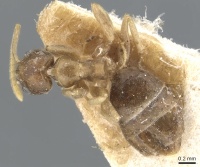Tapinoma luridum
| Tapinoma luridum | |
|---|---|

| |
| Scientific classification | |
| Kingdom: | Animalia |
| Phylum: | Arthropoda |
| Class: | Insecta |
| Order: | Hymenoptera |
| Family: | Formicidae |
| Subfamily: | Dolichoderinae |
| Genus: | Tapinoma |
| Species: | T. luridum |
| Binomial name | |
| Tapinoma luridum Emery, 1908 | |
| Subspecies | |
| |
In Benin, Taylor et al. (2018) reports it as ground nesting at base of Eucalyptus.
Identification
Distribution
Distribution based on Regional Taxon Lists
Afrotropical Region: Benin, Democratic Republic of Congo (type locality), Gambia, Guinea.
Distribution based on AntMaps
Distribution based on AntWeb specimens
Check data from AntWeb
Countries Occupied
| Number of countries occupied by this species based on AntWiki Regional Taxon Lists. In general, fewer countries occupied indicates a narrower range, while more countries indicates a more widespread species. |

|
Estimated Abundance
| Relative abundance based on number of AntMaps records per species (this species within the purple bar). Fewer records (to the left) indicates a less abundant/encountered species while more records (to the right) indicates more abundant/encountered species. |

|
Biology
Castes
Nomenclature
The following information is derived from Barry Bolton's Online Catalogue of the Ants of the World.
- luridum. Tapinoma luridum Emery, 1908b: 188 (w.) DEMOCRATIC REPUBLIC OF CONGO. Current subspecies: nominal plus connexum, longiceps, sokolovi.
Description
References
- Borowiec, L., Salata, S. 2018. Notes on ants (Hymenoptera: Formicidae) from Gambia (Western Africa). Annals of the Upper Silesian Museum in Bytom, Entomology 26 (online 010), 1-13 (doi:10.5281/ZENODO.1243767).
- Emery, C. 1908c. Descriptions d'une genre nouveau et de plusieurs formes nouvelles de fourmis du Congo. Ann. Soc. Entomol. Belg. 52: 184-189 (page 188, worker described)
- Radchenko, A.G., Fisher, B.L., Esteves, F.A., Martynova, E.V., Bazhenova, T.N., Lasarenko, S.N. 2023. Ant type specimens (Hymenoptera, Formicidae) in the collection of Volodymyr Opanasovych Karawajew. Communication 1. Dorylinae, Poneromorpha and Pseudomyrmecinae. Zootaxa, 5244(1), 1–32 (doi:10.11646/zootaxa.5244.1.1).
- Sharaf, M.R., Aldawood, A.S. 2022. Tapinoma yacoubi, sp. nov., a new ant species (Hymenoptera: Formicidae) from Saudi Arabia, Zoology in the Middle East, 68:2, 165-170 (doi:10.1080/09397140.2022.2077565).
- Taylor, B., Agoinon, N., Sinzogan, A., Adandonon, A., Kouaguou, Y. N., Bello, S., Wargui, R., Anato, F., Ouagoussounon, I., Houngbo, H., Tchibozo, S., Todjihounde, R., Vayssieres, J.F. 2018. Records of ants (Hymenoptera: Formicidae) from the Republic of Benin, with particular reference to the mango farm ecosystem. Journal of Insect Biodiversity 8(1): 6-29 (doi:10.12976/jib/2018.08.1.2).
References based on Global Ant Biodiversity Informatics
- Borowiec L., and S. Salata. 2018. Notes on ants (Hymenoptera: Formicidae) from Gambia (Western Africa). Annals of the Upper Silesian Museum in Bytom Entomology 26: 1-13.
- Taylor B., N. Agoinon, A. Sinzogan, A. Adandonon, Y. N'Da Kouagou, S. Bello, R. Wargui, F. Anato, I. Ouagoussounon, H. Houngbo, S. Tchibozo, R. Todjhounde, and J. F. Vayssieres. 2018. Records of ants (Hymenoptera: Formicidae) from the Republic of Benin, with particular reference to the mango farm ecosystem. Journal of Insect Biodiversity 8(1): 006–029.

